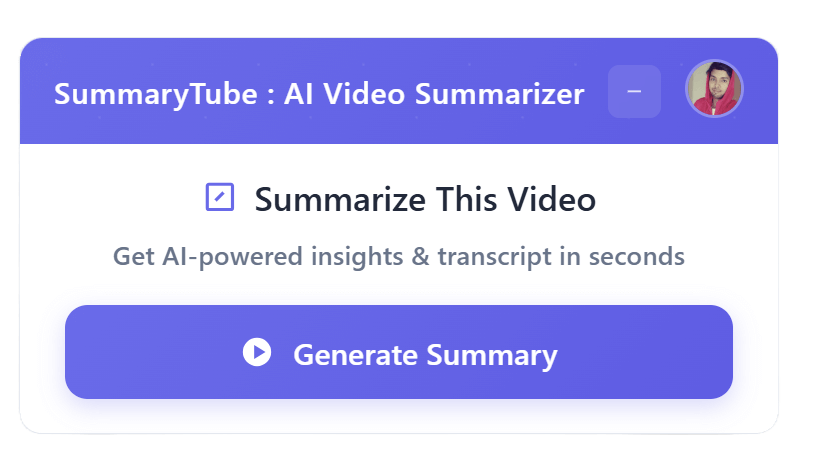Saylor.org BUS209: Tim Clark and David Zinger's "Employee Engagement Mindset"
By Saylor Academy
Published Loading...
N/A views
N/A likes
AI Summary of "Saylor.org BUS209: Tim Clark and David Zinger's "Employee Engagement Mindset""
Get instant insights and key takeaways from this YouTube video by Saylor Academy.
Employee Engagement Mindset
✨ Research involving 60 organizations revealed that 60% of surveyed employees and leaders believe the employee is primarily responsible for engagement, contrasting with 40% who attribute it to the employer.
🧠 Further study of 150 highly engaged employees across 50 organizations confirmed that these "engagement outliers" inherently believe they own their engagement, with the organization serving a secondary, supportive role.
🚫 Organizations cannot "give" engagement, as evidenced by the concept of "happy dead weight," where employees can be content but disengaged despite organizational efforts.
Characteristics of Highly Engaged Employees
🎯 Take personal ownership of their engagement, demonstrating a proactive stance rather than passively awaiting organizational "empowerment."
🌍 Exhibit an "agnostic to context" mindset, maintaining high engagement levels regardless of external conditions like varying bosses or resources.
🛠️ Are primarily driven by the nature of the work itself, seeking out and thriving in roles that are challenging, important, visible, and complex.
Six Drivers of Personal Engagement
🤝 Connecting: Proactively exchange emotional, social, intellectual, and spiritual value, consciously cultivating deeper organizational and interpersonal connections beyond just social ties.
🔧 Shaping: Actively customize and personalize professional experiences within constraints, identifying opportunities to tailor roles and responsibilities to individual preferences.
📚 Learning: Cultivate an aggressive, self-directed learning disposition, consistently acquiring new knowledge, skills, and experiences to adapt to rapid professional changes.
📈 Stretching: Intentionally step out of comfort zones into "discomfort zones" to push personal and professional limits, which is where capacity is built and peak engagement occurs.
✅ Achieving: Focus and sustain efforts to accomplish meaningful goals, breaking down objectives into smaller, manageable steps, as even minor successes energize and motivate.
🎁 Contributing: Direct efforts beyond self towards a meaningful purpose, which is considered the "culminating driver" and highest form of compensation, highlighting personal impact and relationships.
Key Points & Insights
➡️ Employee engagement is fundamentally a personal choice and responsibility, with the organization's role being supportive rather than generative.
➡️ Highly engaged individuals proactively shape their work, continuously learn, and stretch their capabilities, maintaining engagement irrespective of external circumstances.
➡️ The deepest professional satisfaction stems from achieving meaningful goals (even small ones) and contributing to a purpose greater than oneself.
📸 Video summarized with SummaryTube.com on Jul 05, 2025, 13:34 UTC
📜Transcript
Loading transcript...
📄Video Description
TranslateUpgrade
Visit our site to learn about our Free Courses & Free Certificates: https://www.saylor.org/
Follow us on social media:
Bluesky: https://bsky.app/profile/sayloracademy.bsky.social
LinkedIn: https://www.linkedin.com/school/saylor-academy
X (Twitter): https://x.com/saylordotorg
Facebook: https://www.facebook.com/SaylorAcademy
Instagram: https://www.instagram.com/saylordotorg/
Full video URL: youtube.com/watch?v=heaMTK9bWsU
Duration: 44:15
Recently Summarized Videos
💎Related Tags
BUS209EmployeeEngagementMindsetSaylor FoundationOERFree EducationOpen EducationCreative Commonssaylor.orgsaylor
Total Video Summary Page Visits :2
AI Summary of "Saylor.org BUS209: Tim Clark and David Zinger's "Employee Engagement Mindset""
Get instant insights and key takeaways from this YouTube video by Saylor Academy.
Employee Engagement Mindset
✨ Research involving 60 organizations revealed that 60% of surveyed employees and leaders believe the employee is primarily responsible for engagement, contrasting with 40% who attribute it to the employer.
🧠 Further study of 150 highly engaged employees across 50 organizations confirmed that these "engagement outliers" inherently believe they own their engagement, with the organization serving a secondary, supportive role.
🚫 Organizations cannot "give" engagement, as evidenced by the concept of "happy dead weight," where employees can be content but disengaged despite organizational efforts.
Characteristics of Highly Engaged Employees
🎯 Take personal ownership of their engagement, demonstrating a proactive stance rather than passively awaiting organizational "empowerment."
🌍 Exhibit an "agnostic to context" mindset, maintaining high engagement levels regardless of external conditions like varying bosses or resources.
🛠️ Are primarily driven by the nature of the work itself, seeking out and thriving in roles that are challenging, important, visible, and complex.
Six Drivers of Personal Engagement
🤝 Connecting: Proactively exchange emotional, social, intellectual, and spiritual value, consciously cultivating deeper organizational and interpersonal connections beyond just social ties.
🔧 Shaping: Actively customize and personalize professional experiences within constraints, identifying opportunities to tailor roles and responsibilities to individual preferences.
📚 Learning: Cultivate an aggressive, self-directed learning disposition, consistently acquiring new knowledge, skills, and experiences to adapt to rapid professional changes.
📈 Stretching: Intentionally step out of comfort zones into "discomfort zones" to push personal and professional limits, which is where capacity is built and peak engagement occurs.
✅ Achieving: Focus and sustain efforts to accomplish meaningful goals, breaking down objectives into smaller, manageable steps, as even minor successes energize and motivate.
🎁 Contributing: Direct efforts beyond self towards a meaningful purpose, which is considered the "culminating driver" and highest form of compensation, highlighting personal impact and relationships.
Key Points & Insights
➡️ Employee engagement is fundamentally a personal choice and responsibility, with the organization's role being supportive rather than generative.
➡️ Highly engaged individuals proactively shape their work, continuously learn, and stretch their capabilities, maintaining engagement irrespective of external circumstances.
➡️ The deepest professional satisfaction stems from achieving meaningful goals (even small ones) and contributing to a purpose greater than oneself.
📸 Video summarized with SummaryTube.com on Jul 05, 2025, 13:34 UTC
Loading Similar Videos...
Recently Summarized Videos

Get the Chrome Extension
Summarize youtube video with AI directly from any YouTube video page. Save Time.
Install our free Chrome extension. Get expert level summaries with one click.